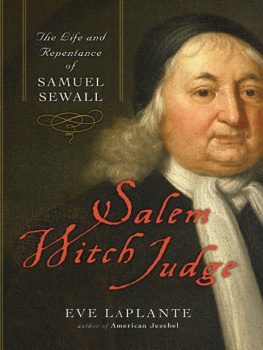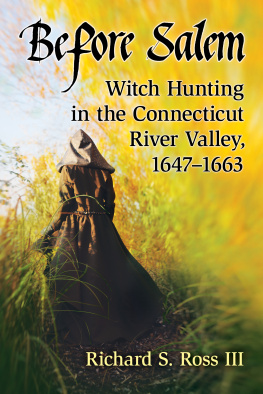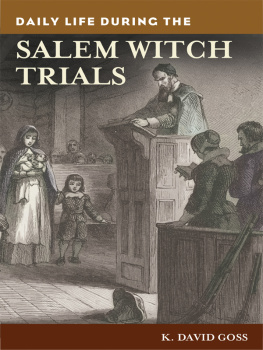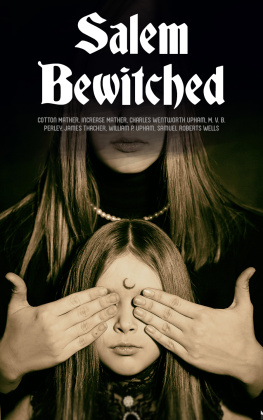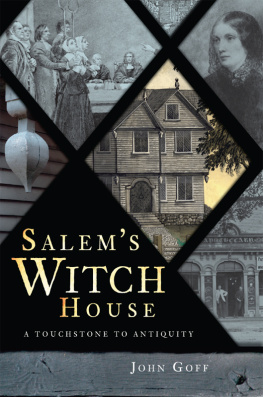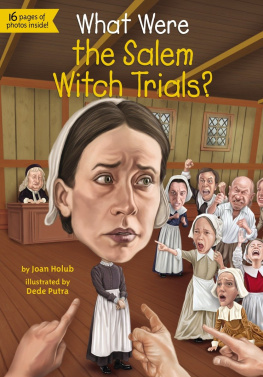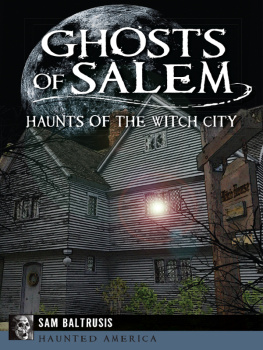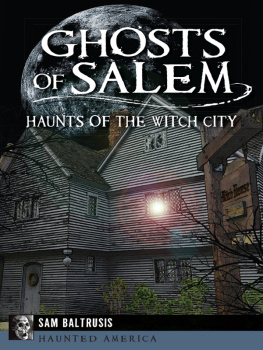Joseph A. LaPlante
19231990
&
Charlotte May Wilson
18951980
Men think tis a disgrace to change their mind. But there is not a greater piece of folly than not to give place to right reason.
This is a work of nonfiction. Dates are old style, using the Julian calendar that English settlers of North America kept until the mid-eighteenth century. Unlike them, however, I begin the year on January 1 rather than March 25. To determine a date from the book in new style, add ten days to it; thus December 21, 1685, in the book is December 31, 1685, by modern reckoning.
I standardize the spelling of names with variant spellings in the seventeenth century, such as Sewell, Susannah, and Thacher, and I use Jr. to distinguish children from parents with the same name. Most quotations from Samuel Sewall are from his diary; those from elsewhere, such as his letters or essays, are indicated as such. In quoting from the writings of Sewall and his contemporaries, I make no changes other than modernizing spelling, capitalization, and punctuation. Except when a source used a different translation, all quotations from the Bible are from the seventeenth-century King James Version.
Quotations from the sung psalms are from the 1640 Whole Book of Psalms, Faithfully Translated into English Meter , also known as the Bay Psalm Book, the first book published in America. The psalm tunes, in modern musical notation, are from the ninth edition of the Bay Psalm Book, published in Cambridge, Massachusetts, in 1698. The musical examples contain the original spelling and punctuation. This is the first time that the tune and full text of these psalms have been printed together on a page, enabling readers to sing for themselves what Sewall sang.
An appendix contains Sewalls three important essays, with his spelling and punctuation. Selected excerpts from Phaenomena quaedam Apocalyptica represent roughly a quarter of that 1697 essay on the role of America and Native Americans in the apocalypse. Sewalls 1700 pamphlet, The Selling of Joseph , Americas first public statement against slavery, is printed in full, as is Talitha Cumi , his 1724 essay on the resurrection of womens bodies.

assachusetts State House mural by Albert Herter, 1942.
Beneath the golden dome of the Massachusetts State House, on a curved wall above the speakers platform in the Chamber of the House of Representatives, is a large mural of my sixth great-grandfather the Salem witch judge. Titled 1697, Dawn of Tolerance in Massachusetts: Public Repentance of Judge Samuel Sewall for His Action in the Witchcraft Trials, the mural shows an old man standing at the front pew in a New England meetinghouse. Everyone else in the crowded church is seated except a minister, who reads aloud Samuel Sewalls statement of repentance for executing twenty innocent people.
Five years earlier, in the summer of 1692, Samuel Sewall sat on the Massachusetts court that tried hundreds of people accused of witchcraft. He heard and believed the Salem Village girls who claimed that their neighbors used ghosts to torture and bewitch them. As the scope of the Devils apparent attack on New England grew, Sewall convicted more than thirty people as witches. He stood by as nineteen women and men were hanged and one man was pressed to death with large stones. Some witchcraft suspects were strangers to him, but others were his friends. One man, a Boston neighbor, was a longtime business associate and fellow member of a private prayer group that met periodically in their homes. Another was a minister who had been a year ahead of him at Harvard College, with whom he corresponded and socialized. In October, after public opinion turned against the court, the governor halted the witchcraft trials. Yet he rewarded Sewall and other Salem witch judges with appointments to a much higher court, and neither he nor the judges made any public statement of regret for the witch hunt. For several years Samuel Sewall struggled with a growing sense of shame and remorse. This private effort culminated in the public moment depicted in the Massachusetts State House mural.
Certain details in the mural are incorrect, although they do not alter its effect. Sewall looks at least seventy years old; he was actually forty-four at the time. Women are scattered among a mostly male crowd; in fact women and men occupied separate sides of a seventeenth-century meetinghouse. Two or three men near Sewall appear to be weeping, yet it is unlikely that his real peers felt much sympathy with him that day. Most of New Englands leading men thought he should not take on himself the blame for the witch hunt. They considered the events of 1692 a tragic mistake. In their view it was best to destroy the documents and move forward.
Samuel Sewall thought differently. Alone among the colonial officials who supported the killing of twenty innocent people, he assumed in public the blame and shame for the 1692 executions. At the moment captured in the mural, Samuel Sewall began a lengthy process of repentance, both public and private, that involved countless hours of prayer and self-mortification. He spent much of the remainder of his lifemore than three decadestrying to restore himself in the eyes of God. This extraordinary urge to acknowledge and make amends for his sin is why he was chosen, along with John Winthrop, John Adams, and John Hancock, as a worthy subject of public art in honor of Milestones on the Road to Freedom.
The repentance of Samuel Sewall represents the greatest movement in modern history, not only in theory, but in its practical application, Frank Grinnell, secretary of the Massachusetts Historical Society, observed at the dedication of the mural in 1942. The moment depicted in the Sewall mural marks the beginning of the recognition of the quality of mercy in human affairs. No principle of Christ has been longer in obtaining whole-hearted acceptance thanthe saying, Be ye merciful even as your Father is merciful. Grinnell explained, Massachusetts has been a target for caustic comment for centuries because of the hysterical and brutal outburst of the witchcraft trials and executions in 1692. But it is forgotten how short it wasbut five monthswith only about a score of hangings, as compared with the thousands burned, hanged or drowned in Spain, France, Germany, England and Scotland in much longer periods. And nowhere, except in connection with Salem, did any of the actors in the tragedy have the moral courage to admit that they were wrong.
The Salem witch trials exposed many strange phases of humanity, according to their seminal nineteenth-century chronicler, Charles Upham, such as folly, delusion, criminal behavior, heroism, integrity, and Christian piety. In regard to the last, The conduct of Judge Sewall claims our particular admiration. He observed annually in private a day of humiliation and prayer, during the remainder of his life, to keep fresh in his mind a sense of repentance and sorrow for the part he bore in the trials.
I first heard of Samuel Sewall when I was a little girl visiting my great-aunt Charlotte May Wilson at the tip of Cape Cod. She lived in the red house beside Provincetowns Red Inn, which she ran. In her spare time she researched the lives of her ancestors, famous and infamous, whose stories she loved to tell. I recall my elderly, childless great-aunt clucking over her forebears like a hen over her brood. On my thirteenth birthday she presented me with a copy of the family tree. Every family, I now believe, has an Aunt Charlotte, the relative who takes the time to learn and share stories about the past.

